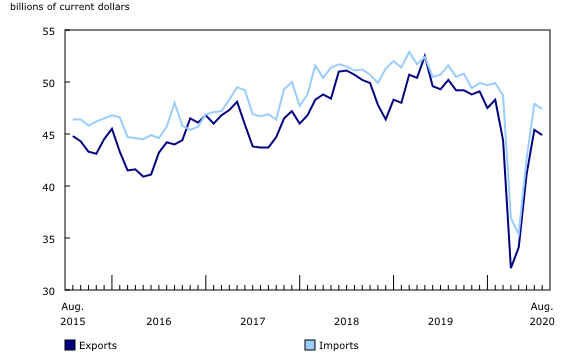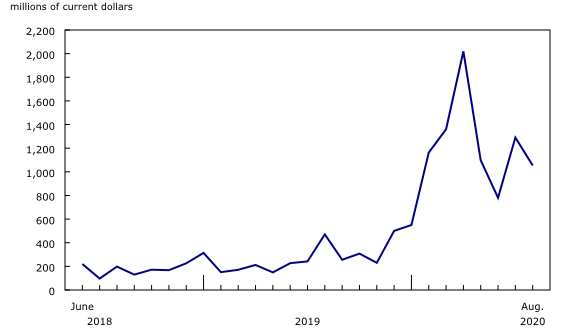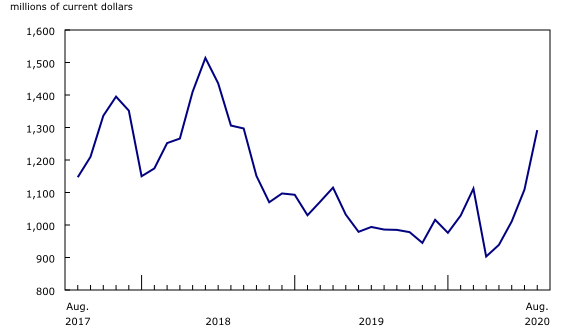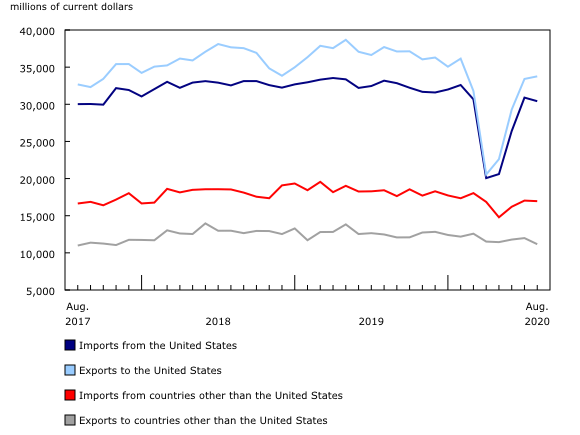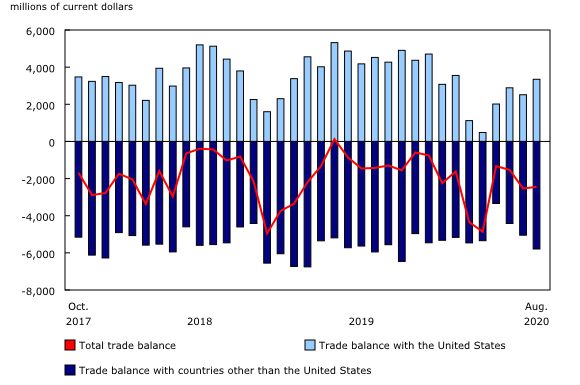Canadian international merchandise trade, August 2020
Archived Content
Information identified as archived is provided for reference, research or recordkeeping purposes. It is not subject to the Government of Canada Web Standards and has not been altered or updated since it was archived. Please "contact us" to request a format other than those available.
Released: 2020-10-06
After two months of strong growth, Canadian merchandise exports and imports stabilized in August. Imports fell 1.2%, while exports were down 1.0%. As a result, Canada's merchandise trade deficit with the world narrowed slightly, from $2.5 billion in July to $2.4 billion in August.
To explore the most recent results from Canada's international merchandise trade in an interactive format, see the new "International merchandise trade monthly interactive dashboard."
Imports of aircraft and aircraft parts fall
In August, total imports fell 1.2%, to $47.4 billion. This was 5.1% below the level observed in February, the month before the economic impacts of the COVID-19 pandemic were felt. Of the 11 product sections, 6 decreased. In real (or volume) terms, imports edged down 0.5%.
Lower imports of aircraft and other transportation equipment and parts (-25.3%) contributed the most to the decline in August. This decrease was partly because of imports of aircraft engines and parts (-21.4%), which fell by more than half between February and May and are struggling to return to the levels posted before that period. Aircraft imports (-49.6%) were also down in August. Although high-value airliners were imported in June and July, no airliners were imported in August.
Imports of metal and non-metallic mineral products (-5.7%) also decreased in August. Imports of gold, silver and platinum group metals (-18.3%), which are mainly comprised of refined gold, contributed the most to the drop in this product section. This decline followed a sharp increase in acquisitions of gold assets by Canadian companies in July, which was not repeated in August. Since the beginning of 2020, imports of gold, silver and platinum group metals are almost five times higher compared with the same period in 2019.
After rising for three consecutive months, imports of industrial machinery, equipment and parts fell 4.4% in August. Other general-purpose machinery and equipment (-6.0%) and parts of industrial machinery and equipment (-6.7%) were the largest contributors to the decline. In August, imports of industrial machinery, equipment and parts were down 9.1% compared with February.
Exports of passenger cars and light trucks decrease
Total exports decreased 1.0%, to $44.9 billion, settling 7.0% lower than February levels. Declines were observed in 6 of the 11 product sections in August, and non-energy exports fell 1.8%. In real (or volume) terms, exports were down 1.4%.
After three consecutive months of strong increases, exports of motor vehicles and parts fell 6.8%, to $7.5 billion. This decrease was led by exports of passenger cars and light trucks (-9.5%). In July, there was an atypical increase in these exports on account of higher production and shorter temporary seasonal stoppages. Despite the monthly decline observed in August, export levels of passenger cars and light trucks ($5.0 billion) were still almost $200 million higher than February levels.
Exports of aircraft and other transportation equipment and parts also contributed to the decline (-14.5%), mainly on lower exports of boats and other transportation equipment (-53.3%). After posting a $408 million increase in July, exports from this product group fell $294 million in August, mainly on lower exports of other transportation equipment to Saudi Arabia.
These decreases were partially offset by higher exports of forestry products and building and packaging materials, which rose 7.6% in August. Higher exports of lumber (+16.5%), which climbed for a fourth consecutive month, drove this increase. The recent increases in lumber exports have been caused by higher prices; the export price index for this product has risen by more than one-third since May. This price growth was influenced by a combination of lower supply and higher demand. On one hand, softwood lumber production has decreased because of the pandemic. On the other hand, there has been a recent increase in new housing starts in the United States.
The exchange rate rose in August
In August, the average value of the Canadian dollar rose 1.5 cents US from July. Although this gain is not unprecedented, it is still significant since import and export transactions are largely completed in US dollars. When expressed in US dollars, Canadian exports rose 1.0% in August, and imports were up 0.8%.
Imports from the United States decline
After three consecutive monthly increases, imports from the United States fell 1.6%, to $30.4 billion, in August, a 6.7% decrease compared with February.
Exports to the United States were up 1.0%, to $33.8 billion, in August. This was a fourth consecutive monthly gain, and was led in part by higher lumber exports. Exports to the United States were 6.6% below the level observed in February. As a result, Canada's trade surplus with the United States widened from $2.5 billion in July to $3.3 billion in August, the highest surplus since February.
After rising 9.6% in June and 5.1% in July, imports from countries other than the United States (-0.4%) stabilized in August. Lower imports from Ireland (aircraft) and Mexico (passenger cars and light trucks) were partially offset by higher imports from Vietnam (cellphones) and China (various products). In August, the level of imports from countries other than the United States was 2.3% lower than the level observed in February.
Exports to countries other than the United States decreased 6.8%, to $11.2 billion, the lowest level observed since November 2017. Exports to Saudi Arabia (other transportation equipment), the United Kingdom (refined gold) and Italy (pharmaceutical products and wheat) contributed the most to the decline. In August, the level of exports to countries other than the United States was 8.3% lower than in February.
Canada's trade deficit with countries other than the United States widened from $5.0 billion in July to $5.8 billion in August.
Impact of the Port of Montréal strike on Canada's international trade
In August, there was a work stoppage among longshore workers at the Port of Montréal, which lasted almost two weeks. Canadian international merchandise trade customs data (non-seasonally adjusted) show that the national share of exports by water through the Port of Montréal was 7.8% in August; this share is normally around 15% (2019 monthly average). At the same time, in August, the share of exports through the ports of Québec and Halifax increased moderately. No significant impact was observed with respect to imports.
Revisions to July merchandise exports and imports
Imports in July, originally reported as $47.9 billion, were essentially unchanged in the current month's release. Exports in July, originally reported as $45.4 billion, were also essentially unchanged in the release of August data.
Trade in medical and protective goods
In August, imports of medical and protective goods declined 0.8%, the second consecutive monthly decrease. Despite the monthly decrease, these imports were 46.1% higher compared with August 2019. There were lower imports of diagnostic products (-24.4%) and personal protective equipment (-12.5%). Higher imports of medical equipment and products (+20.4%) partially offset these declines. Exports of medical and protective goods increased 8.5% in August, mainly on higher exports of medicaments. Exports in most sub-groups posted year-over-year increases.
Monthly trade in services
In August, monthly service exports were up 0.9%, to $8.8 billion, and service imports increased 1.3%, to $8.7 billion.
When international trade in goods and services combined is considered, exports decreased 0.7%, to $53.8 billion, in August, while imports fell 0.8%, to $56.0 billion. As a result, Canada's trade deficit with the world for goods and services combined was $2.3 billion in August.
Note to readers
Merchandise trade is one component of Canada's international balance of payments (BOP), which also includes trade in services, investment income, current transfers, and capital and financial flows.
International trade data by commodity are available on both a BOP and a customs basis. International trade data by country are available on a customs basis for all countries, and on a BOP basis for Canada's 27 principal trading partners (PTPs). The list of PTPs is based on their annual share of total merchandise trade—imports and exports—with Canada in 2012. BOP data are derived from customs data by making adjustments for factors such as valuation, coverage, timing and residency. These adjustments are made to conform to the concepts and definitions of the Canadian System of National Accounts.
For a conceptual analysis of BOP-based data versus customs-based data, see "Balance of Payments trade in goods at Statistics Canada: Expanding geographic detail to 27 principal trading partners."
For more information on these and other macroeconomic concepts, see the Methodological Guide: Canadian System of Macroeconomic Accounts (13-607-X) and the User Guide: Canadian System of Macroeconomic Accounts (13-606-G).
Data in this release are on a BOP basis and are seasonally adjusted. Unless otherwise stated, values are expressed in nominal terms, or current dollars. References to prices are based on aggregate Paasche (current-weighted) price indexes (2012=100). Movements within aggregate Paasche prices can be influenced by changes in the share of values traded for specific goods, with sudden shifts in trading patterns—as observed currently with the pandemic—sometimes resulting in large movements in Paasche price indexes. Volumes, or constant dollars, are calculated using the Laspeyres formula (2012=100) unless otherwise stated.
For information on seasonal adjustment, see Seasonally adjusted data – Frequently asked questions.
Revisions
In general, merchandise trade data are revised on an ongoing basis for each month of the current year. Current-year revisions are reflected in both the customs-based and BOP-based data.
The previous year's customs-based data are revised with the release of data for the January and February reference months, and thereafter on a quarterly basis. The previous two years of customs-based data are revised annually, and revisions are released in February with the December reference month.
The previous year's BOP-based data are revised with the release of data for the January, February, March and April reference months. To remain consistent with the Canadian System of Macroeconomic Accounts, revisions to BOP-based data for previous years are released annually in December with the October reference month.
Factors influencing revisions include the late receipt of import and export documentation, incorrect information on customs forms, the replacement of estimates produced for the energy section with actual figures, changes in merchandise classification based on more current information, and changes to seasonal adjustment factors.
Revised data are available in the appropriate tables.
Real-time data table
Real-time table 12-10-0120-01 will be updated on October 19.
Next release
Data on Canadian international merchandise trade for September will be released on November 4.
Products
The product International merchandise trade monthly interactive dashboard (71-607-X) is now available. This new interactive dashboard is a comprehensive analytical tool that presents monthly changes in Canada's international merchandise trade data on a balance of payments basis, fully supporting the information presented every month in the Daily text.
The product The International Trade Explorer (71-607-X) is now available online.
Customs-based data are now available in the Canadian International Merchandise Trade Database (65F0013X).
The updated Canada and the World Statistics Hub (13-609-X) is now available online. This product illustrates the nature and extent of Canada's economic and financial relationship with the world using interactive graphs and tables. This product provides easy access to information on trade, investment, employment and travel between Canada and a number of countries, including the United States, the United Kingdom, Mexico, China, Japan, Belgium, Italy, the Netherlands and Spain.
Contact information
For more information, contact us (toll-free 1-800-263-1136; 514-283-8300; STATCAN.infostats-infostats.STATCAN@canada.ca).
To enquire about the concepts, methods or data quality of this release, contact Benoît Carrière (613-415-5305; benoit.carriere@canada.ca), International Accounts and Trade Division.
- Date modified:



